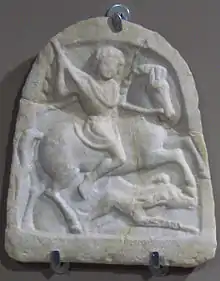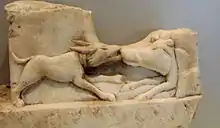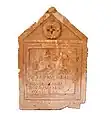Thracian horseman
The Thracian horseman (also "Thracian Rider" or "Thracian Heros") is a recurring motif depicted in reliefs of the Hellenistic and Roman periods in the Balkans—mainly Thrace, Macedonia,[1][2] Thessaly[3] and Moesia—roughly from the 3rd century BC to the 3rd century AD. Inscriptions found in Romania identify the horseman as Heros and Eros (latin transcriptions of Ἥρως) and also Herron and Eron (latin transcriptions of Ἥρων), apparently the word heros used as a proper name.[3] He is sometimes addressed in inscriptions merely as κύριος, δεσπότης or ἥρως.[4] Inscriptions from Bulgaria give the names Salenos and Pyrmerula/Pirmerula.[5]


The Thracian horseman is depicted as a hunter on horseback, riding from left to right. Between the horse's hooves is depicted either a hunting dog or a boar. In some instances, the dog is replaced by a lion. Its depiction is in the tradition of the funerary steles of Roman cavalrymen, with the addition of syncretistic elements from Hellenistic and Paleo-Balkanic religious or mythological tradition.
Late Roman syncretism
The Cult of the Thracian horseman was especially important in Philippi, where the Heros had the epithets of soter (saviour) and epekoos "answerer of prayers". Funerary stelae depicting the horseman belong to the middle or lower classes (while the upper classes preferred the depiction of banquet scenes).[6]
The motif most likely represents a composite figure, a Thracian heroes possibly based on Rhesus, the Thracian king mentioned in the Iliad,[7] to which Scythian, Hellenistic and possibly other elements had been added.[8]
Under the Roman Emperor Gordian III the god on horseback appears on coins minted at Tlos, in neighboring Lycia, and at Istrus, in the province of Lower Moesia, between Thrace and the Danube.[9]
In the Roman era, the "Thracian horseman" iconography is further syncretised. The rider is now sometimes shown as approaching a tree entwined by a serpent, or as approaching a goddess. These motifs are partly of Greco-Roman and partly of possible Scythian origin. The motif of a horseman with his right arm raised advancing towards a seated female figure is related to Scythian iconographic tradition. It is frequently found in Bulgaria, associated with Asclepius and Hygeia.[10]
Stelai dedicated to the Thracian Heros Archegetas have been found at Selymbria.[11]
Epithets
Apart from syncretism with other deities (such as Asclepios, Apollo, Sabatius), the figure of the Thracian Horseman was also found with several epithets: Karabasmos, Keilade(i)nos, Manimazos, Aularchenos, Aulosadenos, Pyrmeroulas. One in particular was found in Avren, dating from the III century CE, with a designation that seems to refer to horsemanship: Outaspios, and variations Betespios, Ephippios and Ouetespios.[12]
Twin horsemen
Related to the Dioscuri motif is the so-called "Danubian Horsemen" motif of two horsemen flanking a standing goddess.[13][14] These "Danubian horsemen" are thus called due to their reliefs being found in the Roman province of Danube. However, some reliefs have also been found in Roman Dacia - which gives the alternate name for the motif: "Dacian Horseman".[15] Scholarship locates its diffusion across Moesia, Dacia, Pannonia and Danube, and, to a lesser degree, in Dalmatia and Thracia.[16][17]
The motif of a standing goddess flanked by two horsemen, identified as Artemis flanked by the Dioscuri, and a tree entwined by a serpent flanked by the Dioscuri on horseback was transformed into a motif of a single horseman approaching the goddess or the tree.[18]
Madara Rider
The Madara Rider is an early medieval large rock relief carved on the Madara Plateau east of Shumen in northeastern Bulgaria. The monument is dated in the c. 7th/8th century, during the reign of Bulgar Khan Tervel. In 1979 became enlisted on the UNESCO World Heritage List.
Other, similar figures
The relief of the Madara Rider in Bulgaria, listed as a UNESCO World Heritage Site[19] incorporates elements of the autochthonous Thracian cult.[20]
The motif of the Thracian horseman was continued in Christianised form in the equestrian iconography of both Saint George and Saint Demetrius.[21][22][23][24][25]
The motif of the Thracian horseman is not to be confused with the depiction of a rider slaying a barbarian enemy on funerary stelae, as on the Stele of Dexileos, interpreted as depictions of a heroic episode from the life of the deceased.[26]
Gallery
- Hunter motif
 Thracian horseman with hound and boar, Greek inscription (3rd century BC), Teteven museum
Thracian horseman with hound and boar, Greek inscription (3rd century BC), Teteven museum Thracian horseman attacking a lion which is in turn attacking its prey. Madara Museum, Bulgaria
Thracian horseman attacking a lion which is in turn attacking its prey. Madara Museum, Bulgaria Statue of a Thracian horseman with lion, 3rd century, National History Museum of Bulgaria
Statue of a Thracian horseman with lion, 3rd century, National History Museum of Bulgaria Thracian horseman, funerary stele with Greek inscription, Madara Museum, Bulgaria
Thracian horseman, funerary stele with Greek inscription, Madara Museum, Bulgaria Thracian horseman with hound, marble votive tablet, Stara Zagora regional history museum
Thracian horseman with hound, marble votive tablet, Stara Zagora regional history museum
- Serpent-and-tree
 Thracian horseman with hound and serpent-entwined tree, funerary stele for one Caius Cornelius at Philippi.
Thracian horseman with hound and serpent-entwined tree, funerary stele for one Caius Cornelius at Philippi..jpg.webp) Thracian horseman with hounds, a serpent-entwined tree and a footman (3rd century), Constanța History and Archaeology Museum
Thracian horseman with hounds, a serpent-entwined tree and a footman (3rd century), Constanța History and Archaeology Museum Thracian horseman with hounds, footman and tree, Haskovo Historic Museum, Bulgaria
Thracian horseman with hounds, footman and tree, Haskovo Historic Museum, Bulgaria Thracian horseman with a serpent-entwined tree, Histria Museum, Romania
Thracian horseman with a serpent-entwined tree, Histria Museum, Romania Thracian horseman with serpent-and-tree, the National History Museum of Bulgaria
Thracian horseman with serpent-and-tree, the National History Museum of Bulgaria Thracian horseman with serpent-and-tree (2nd century), Burgas Archaeological Museum, Bulgaria
Thracian horseman with serpent-and-tree (2nd century), Burgas Archaeological Museum, Bulgaria Thracian horseman with serpent-and-tree, Expoziţia Cultura Cucuteni
Thracian horseman with serpent-and-tree, Expoziţia Cultura Cucuteni
- Rider and goddess
 Thracian rider of "Scythian" type, with raised hand, riding towards female figure, Madara Museum, Bulgaria
Thracian rider of "Scythian" type, with raised hand, riding towards female figure, Madara Museum, Bulgaria Horseman approaching seated female figure under a tree, Constanta Museum
Horseman approaching seated female figure under a tree, Constanta Museum
- Greco-Roman comparanda
 Black figure Thracian cavalrymen vs. armored Greek foot soldier (Getty Villa Collection, c. 520 BC)
Black figure Thracian cavalrymen vs. armored Greek foot soldier (Getty Villa Collection, c. 520 BC) Stele of Dexileos (c. 390 BC)
Stele of Dexileos (c. 390 BC) Funerary relief of a Roman cavalryman (2nd/3rd century)
Funerary relief of a Roman cavalryman (2nd/3rd century) Funerary relief of a late (4th/5th century?) Roman cavalryman trampling a barbarian warrior, Roman Britain (Chester, Grosvenor Museum)
Funerary relief of a late (4th/5th century?) Roman cavalryman trampling a barbarian warrior, Roman Britain (Chester, Grosvenor Museum) A fragment of a decorated frieze at Felix Romuliana, a palace built by the emperor Galerius in modern-day Serbia. The fragment depicts a rider wielding an ax, and a shield-bearing soldier on foot.
A fragment of a decorated frieze at Felix Romuliana, a palace built by the emperor Galerius in modern-day Serbia. The fragment depicts a rider wielding an ax, and a shield-bearing soldier on foot..jpg.webp) "Danubian Horsemen" (Artemis flanked by the Dioscuri), votive plate found in Demir Kapija, North Macedonia
"Danubian Horsemen" (Artemis flanked by the Dioscuri), votive plate found in Demir Kapija, North Macedonia
- Medieval comparanda
 The Madara Rider, equestrian rock relief in Bulgaria (c. 700)
The Madara Rider, equestrian rock relief in Bulgaria (c. 700) "St George of Labechina", Racha, Georgia (11th century), known as the oldest extant equestrian depiction of St George (but note that the horseman is trampling a human opponent rather than a dragon)
"St George of Labechina", Racha, Georgia (11th century), known as the oldest extant equestrian depiction of St George (but note that the horseman is trampling a human opponent rather than a dragon)_crop.jpg.webp) Equestrian depiction of Saints George and Demetrius
Equestrian depiction of Saints George and Demetrius
See also
- Uastyrdzhi
- Tetri Giorgi
- Sabazios
- Bellerophon
- Jupiter Column
- Pahonia
- Heros Peninsula in Antarctica is named after the Thracian Horseman.
- Castor and Pollux, sometimes linked to the Danubian Rider.
References
- Samsaris, Dimitrios C. (1984). Le culte du Cavalier thrace dans la vallée du Bas-Strymon à l' époque romaine: Recherches sur la localisation de ses sanctuaires. Dritter Internationaler Thrakologischer Kongress, Wien, 2-6 Juni 1980. Sofia. Bd. II, p. 284 sqq.
- Samsaris, Dimitrios C. (1982–1983). "Le culte du Cavalier thrace dans la colonie romaine de Philippes et dans son territoire". Ponto-Baltica. 2–3: 89–100.
- Hampartumian, Nubar. (1979). Moesia Inferior (Romanian Section) and Dacia, Volume 74, Part 4,
- The Thracian Cult of Rhesus and the Heros Equitans
- Petrova, S. et al (2015). Thrаcian, Greek, Roman And Medieval Cities, Residences & Fortresses In Bulgaria, Page 370
- Ascough, Richard S. (2003). Paul's Macedonian Associations: The Social Context of Philippians and 1 Thessalonians p. 159.
- West, Rebecca (21 December 2010). Black Lamb and Grey Falcon: A Journey Through Yugoslavia. Open Road Media. p. 455. ISBN 978-1-4532-0746-8.
- Hoddinott, R.F. (1963). Early Byzantine Churches in Macedonia & Southern Serbia, 58–62
- Sabazios on coins, illustrated in the M. Halkam collection.
- Hoddinott (1963:58)
- Byzantium and the Bosporus: A Historical Study, from the Seventh Century BC Until the Foundation of Constantinople, p. 203
- Petraccia, Maria Federica. "La dedica di uno stationarius all’ Heros Outaspios". In: Culti e religiosità nelle province danubiane: Atti del II Convegno Internazionale (Ferrara 20-22 Novembre 2013), a cura di Livio Zerbini. Pubblicazione del LAD (Laboratorio di studi e ricerche sulle Antiche province Danubiane) - Università degli Studi di Ferrara - Dipartimento di Studi Umanistici. Bologna: I libri di Emil. 2015. pp. 594-595, 601. ISBN 978-88-6680-130-6.
- "Relief Of Danubian Horseman Found In Viminacium". Archeology News Network. Online: 14-12-2014. Retrieved: 08-12-2021.
- Vladimirovich, Shchemelev Artem. "К ВОПРОСУ О КЛАССИФИКАЦИИ ИЗОБРАЖЕНИЙ ДУНАЙСКОГО ВСАДНИКА". [ON THE ISSUE OF CLASSIFYING THE DANUBIAN HORSEMAN IMAGES]. In: Historical, Philosophical, Political and Law Sciences, Culturology and Study of Art. Issues of Theory and Practice. Tambov: Gramota, 2015. № 10. Part 2. p. 216.
- Vladimirovich, Shchemelev Artem. "ДУНАЙСКИЙ ВСАДНИК: СУЩНОСТЬ ФЕНОМЕНА И ОСОБЕННОСТИ ИКОНОГРАФИИ" [THE DANUBIAN HORSEMAN: ESSENCE OF THE PHENOMENON AND ITS ICONOGRAPHIC PECULIARITIES]. In: Historical, Philosophical, Political and Law Sciences, Culturology and Study of Art. Issues of Theory and Practice. Tambov: Gramota, 2015. № 8. Part 3. pp. 214-215.
- Vladimirovich, Shchemelev Artem. "ДУНАЙСКИЙ ВСАДНИК: СУЩНОСТЬ ФЕНОМЕНА И ОСОБЕННОСТИ ИКОНОГРАФИИ" [THE DANUBIAN HORSEMAN: ESSENCE OF THE PHENOMENON AND ITS ICONOGRAPHIC PECULIARITIES]. In: Historical, Philosophical, Political and Law Sciences, Culturology and Study of Art. Issues of Theory and Practice. Tambov: Gramota, 2015. № 8. Part 3. p. 215.
- Vladimirovich, Shchemelev Artem. "К ВОПРОСУ О КЛАССИФИКАЦИИ ИЗОБРАЖЕНИЙ ДУНАЙСКОГО ВСАДНИКА". [ON THE ISSUE OF CLASSIFYING THE DANUBIAN HORSEMAN IMAGES]. In: Historical, Philosophical, Political and Law Sciences, Culturology and Study of Art. Issues of Theory and Practice. Tambov: Gramota, 2015. № 10. Part 2. p. 216.
- Hoddinott (1963:59)
- Donchev 1981, p. 46.
- Donchev 1981, p. 43.
- Hoddinott (1963:61)
- de Laet, Sigfried J. (1994). History of Humanity: From the seventh to the sixteenth century. Routledge. pp. 233 ff. ISBN 978-92-3-102813-7.
- Walter, Christopher (2003). The Warrior Saints in Byzantine Art and Tradition. Ashgate. pp. 88ff. ISBN 978-1-84014-694-3.
- c.f. the badly damaged wall painting of St.George in the ruins of Đurđevi stupovi, Serbia (c. 1168)
- Hoddinott (1963:61).
- Hoddinott (1963:60)
Bibliography
- Donchev, Slavi (1981). The Madara Horseman (PDF). Vol. 23–24. ICOMOS. pp. 41–46.
- Dumitru Tudor, Christopher Holme (trans.), Corpus Monumentorum Religionis Equitum Danuvinorum (CMRED) (1976)
- Dimitrova, Nora. "Inscriptions and Iconography in the Monuments of the Thracian Rider." Hesperia: The Journal of the American School of Classical Studies at Athens 71, no. 2 (2002): 209-29. Accessed June 26, 2020. www.jstor.org/stable/3182007.
- Grbić Dragana (2013). "The Thracian hero on the Danube new interpretation of an inscription from Diana". Balcanica (44): 7–20. doi:10.2298/BALC1344007G.
- R. F. Hoddinott. (1963). Early Byzantine Churches in Macedonia & Southern Serbia Google Books
- Irina Nemeti, Sorin Nemeti, Heros Equitans in the Funerary Iconography of Dacia Porolissensis. Models and Workshops. In: Dacia LVIII, 2014, p. 241-255, http://www.daciajournal.ro/pdf/dacia_2014/art_10_nemeti_nemeti.pdf
Further reading
- Boteva, Dilyana. "À propos des "secrets" du Cavalier thrace". In: Dialogues d'histoire ancienne, vol. 26, n°1, 2000. pp. 109-118. [DOI: https://doi.org/10.3406/dha.2000.2414] ; www.persee.fr/doc/dha_0755-7256_2000_num_26_1_2414
- Bottez, Valentin; Topoleanu, Florin. "A New Relief of the Thracian Horseman from Halmyris". In: Peuce (Serie Nouă) - Studii şi cercetari de istorie şi arheologie n. 19, XIX/2021, pp. 135-142.
- DIMITROVA, Nora; CLINTON, Kevin. "Chapter 2. A new bilingual votive monument with a “Thracian rider” relief". In: Studies in Greek epigraphy and history in honor of Stefen V. Tracy [en ligne]. Pessac: Ausonius Éditions, 2010 (généré le 29 juin 2021). Disponible sur Internet: <http://books.openedition.org/ausonius/2108>. ISBN 9782356132819. DOI: https://doi.org/10.4000/books.ausonius.2108.
- Grbić, Dragana. "The Thracian Hero on the Danube: New Interpretation of an Inscription from Diana". In: Balcanica, 2013, XLIV, 7-20. DOI: 10.2298/BALC1344007G
- Kirov, Slavtcho. "Sur la datation du culte du Cavalier thrace" [On the dating of the cult of the Thracian horseman]. In: Studia Academica Šumenensia 7 (2020): 172-186.
- Krykin, S.M. "A Votive Bas-Relief of a Thracian Horseman From the Poltava Museum". In: Ancient Civilizations from Scythia to Siberia 2, 3 (1996): 283-288. doi: https://doi.org/10.1163/157005795X00164
- Mackintosh, Majorie Carol (1992). The divine horseman in the art of the western Roman Empire. PhD thesis. The Open University. pp. 132-159.
- Szabó, Csaba. "BEYOND ICONOGRAPHY. NOTES ON THE CULT OF THE THRACIAN RIDER IN APULUM". In: Studia Universitatis Babes-Bolyai - Historia n. 1, 61/2016, pp. 62-73.
- Toporov, V. (1990). "The Thracian Horseman in an Indo-European Perspective". ORPHEUS. Journal of Indo-European and Thracian Studies. 18: 46–63.
On the "Danubian Horsemen" or "Danubian Riders":
- Bondoc, Dorel. "The representation of Danubian Horsemen from Ciupercenii Vechi, Dolj County". In: La Dacie et l´Empire romain. Mélanges d´épigraphie et d´archéologie offerts à Constantin C. Petolescu. Eds. M. Popescu, I. Achim, F. Matei-Popescu. București: 2018, pp. 229-257.
- Gočeva, Zlatozara. "Encore une Fois sur la “Déesse de Razgrad” et les Plus Anciens des “Cavaliers Danubiens”" [Again on the “Goddess from Razgrad” and the Most Ancient “Danube Horsemen”]. In: Thracia 19 (2011): 149-157.
- Hadiji, Maria Vasinca. "CULTUL CAVALERILOR DANUBIENI: ORIGINI SI DENUMIRE (I)" [THE WORSHIP OF THE DANUBIAN HORSEMEN: ORIGINS AND DESIGNATION (I)]. In: Apulum n. 1, 43/2006, pp. 253-267.
- Kremer, Gabrielle. "Some remarks about Domnus/Domna and the ‚Danubian Riders‘. In: S. Nemeti; E. Beu-Dachin; I. Nemeti; D. Dana (Hrsg.). The Roman Provinces. Mechanisms of Integration. Cluj-Napoca, 2019. pp. 275–290.
- Nemeti, Sorin; Cristean, Ștefana. "New Reliefs Plaques from Pojejena (Caraș-Severin county) depicting the Danubian Riders". In: Ziridava. Studia Archaeologica n. 1, 34/2020. pp. 277-286.
- Strokova, Lyudmila; Vitalii Zubar, and Mikhail Yu Treister. "Two Lead Plaques with a Depiction of a Danubian Horseman from the Collection of the National Museum of the History of the Ukraine". In: Ancient Civilizations from Scythia to Siberia 10, 1-2 (2004): 67-76. doi: https://doi.org/10.1163/1570057041963949
- Szabó, Ádám. Domna et Domnus. CONTRIBUTIONS TO THE CULT-HISTORY OF THE ’DANUBIAN-RIDERS’ RELIGION. Hungarian Polis Studies 25, Phoibos Verlag, Wien, 2017. ISBN 978-3-85161-179-3.
- Tudor, D. Corpus monumentorum religionis equitum danuvinorum (CMRED). Volume 1: Monuments. Leiden, The Netherlands: Brill. 24 Aug. 2015 [1969]. doi: https://doi.org/10.1163/9789004294745
- Tudor, D. Corpus monumentorum religionis equitum danuvinorum (CMRED). Volume 2: Analysis and Interpretation of the Monuments; Leiden, The Netherlands: Brill, 24 Aug. 2015 [1976]. doi: https://doi.org/10.1163/9789004294752